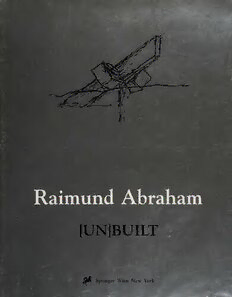
Raimund Abraham [UN]BUILT PDF
Preview Raimund Abraham [UN]BUILT
. Abraham £?Ji Springer Wien New York The Austrian architect RAIMUND ABRAHAM, bom in 1933 in Lienz, Tyrol, has been living, working and teaching in the U.S.A. since 1964- As an exponent of the Viennese avant-garde of the early sixties his work was exhibited together with the works of Hans Hollein and Walter Piohler at the Museum of Modern Art in New York in 1967. The architectural drawing occupies a central position in the evolution of Abraham’s work in challenging the predominant notion of built architecture. Drawing demands an autonomous reality, a manifestation of his architectural concept. Abraham’ drawings and projects as well as the built realizations reflect the roots of a concise architectural theory. The essential notion of “collision” becomes a dialectical theorem as well as the ontological foundation of architecture. “For Abraham, history is an irreversible unfolding, and no culture worthy of its name can be predicated on historicism or any of its more surreptitious derivatives. On the other hand, unlike the avant- garde of the heroic period, he has no use whatsoever for the myth of progress. For him, as for Van Eyck, there remains only the unchanging archetypal condition of man, from which a valid culture of architecture remains to be derived. Abraham distinguishes himself from the “avant-garde” by virtue of his insistence on an ontology which antedates Humanism. This ontological approach in no way pre-supposes a rejection of modern technology just as it does not depend upon the exclusion of traditional materials. It seeks instead an articulate delineation of tectonic elements in which, as in the work of Mies van der Rohe or Carlo Scarpa, old and new, machine-made parts and hand-crafted materials, co-exist in an articulate continuum.” Kenneth Frampton, Reality and Representation in Contemporary Architecture, 1982 ■ ' With an introductory essay by NORBERT MILLER, professor of comparative literature at the Technical University of Berlin, author of Archaologie des Traumes, Versuch tiber G.B. Piranesi and editor of Daidalos. With contributions by JOHN HEJDUK, KENNETH FRAMPTON, P. ADAMS SITNEY, LEBBEUS WOODS, \ WIELAND SCHMIED. ... ,Vn; - - Edited by Brigitte Groihofer. IUNIBU1LT Digitized by the Internet Archive in 2019 with funding from Kahle/Austin Foundation https://archive.org/details/unbuiltOOOOabra Raimund Abraham lUNlBUILT With an introductory essay by NORBERT MILLER With contributions by JOHN HEJDUK KENNETH FRAMPTON P. ADAMS SITNEY LEBBEUS WOODS WIELAND SCHMIED Edited by Brigitte Groihofer Springer Wien New York N6811.5 . A26 Edited by Brigitte Groihofer Graphic Design: Maria-Anna Friedl Translation: Maria E. Clay, Camilla Nielsen This work is subject to copyright. All rights are reserved, whether the whole or part of the material is concerned, specifically those of translation, reprinting, re-use of illustrations, broadcasting, reproduction by photocopying machines or similar means, and storage in data banks. © 1996 Springer-Verlag/Wien Printed in Slovenia Reproductions: Nova Grafika, 66250 II. Bistrica Printing: Tiskama Ljudske pravice, 61104 Ljubljana Printed on acid-free and chlorine-free bleached paper With 402 partly colored figures ISBN 3-211-82671-8 Springer-Verlag Wien New York TO THE MEMORY OF MY FATHER ANTON ABRAHAM WHO TAUGHT ME THE VIRTUE OF LABOR ACKNOWLEDGMENTS In the making of my work 1 have received encouragement and crucial support from friends, peers and institutions. I give my thanks and express my gratitude: To my friend John Hejduk, Architect and Dean of the Irwin S. Chanin School of Architecture. His continuous and unequivocal support during my tenure at Cooper Union made this book possible. To the Cooper Union for the Advancement of Science and Art and to its presidents John F. White, Bill N. Lacy and Jay Islin. To Friedrich St. Florian, who brought me to America and to the Rhode Island School of Design. To Frederik Kiesler, who shared his vision and his house with me. To John Lobell, and the Architectural League of New York. To Kurt Kalb and the Galerie Grunangergasse, Wien. To Peter Cook, Alvin Boyarsky and the Architectural Association, London. To Philip Johnson, Arthur Drexler, Ludwig Glaeser, Terrence Riley and the Museum of Modern Art in New York. To Carter H. Manny and the Graham Foundation, Chicago. To Pontus Holten and the Moderna Museet, Stockholm. To Josef Kleihues and the Internationale Bauaustellung, Berlin. To John Kluge and Metro Media, New York. To Heinrich Klotz and the Architekturmuseum, Frankfurt. To Wieland Schmied and the DAAD, Berlin. To Gunther Domenig and the Technische Universitat, Graz. To Christoph Mayr-Fingerle and the Galerie Museum, Bozen. To Peter Noever and the Museum fur Angewandte Kunst, Wien. To Kenneth Frampton for his critical insights and to my friends Walter Pichler, Peter Kubelka, Hermann Nitsch, P. Adams Sitney and Jonas Mekas, pillars of inspiration. I am indebted to all those who have assisted me in my work with dedication and compassion and have provided me with critical arguments: Anders Abraham, Kevin Bone, Jeffrey Brown, Heiki Buttner, Paxson Kimbrough, Peter Leeb, Andrea Lenardin, Joe Levin, Paul Lubowicki, John Maruszczak, Klaus Neumann, Catherine Seavitt, Warren Ser, Gisela Strohmeier, John Veikos, Guido Zuliani. Special Thanks To Brigitte Groihofer, who succeeded in the almost impossible task of archiving my work and coordinating the production of this book. To Maria-Anna Friedl for her impeccable eye and her patience. To Rudolf Siegle, who never lost faith in his author.
